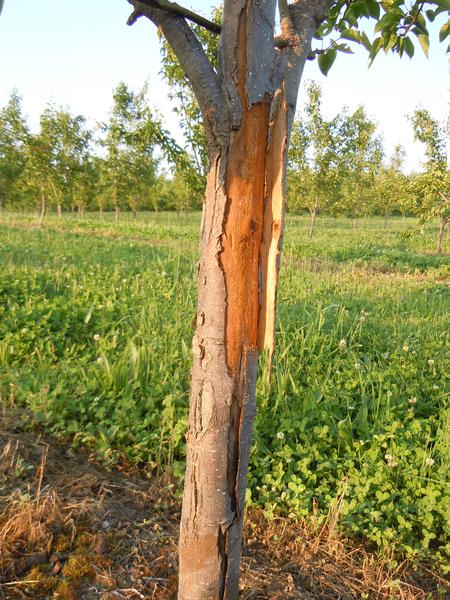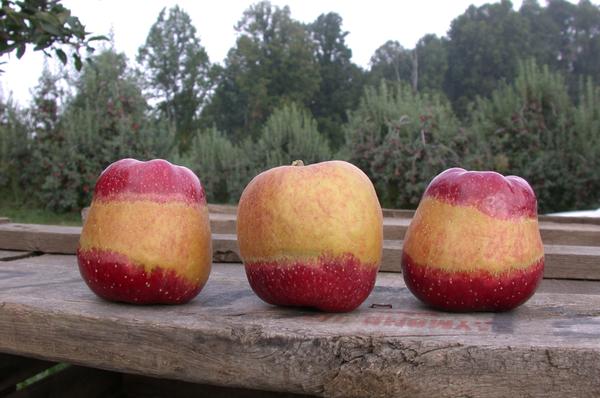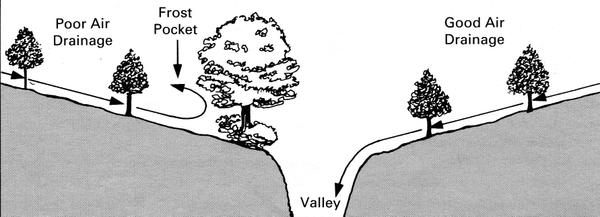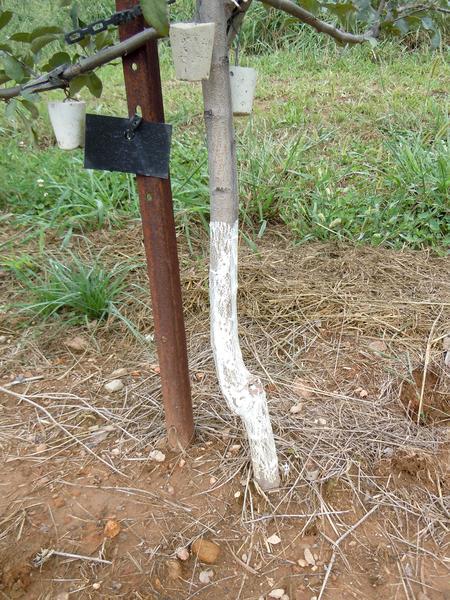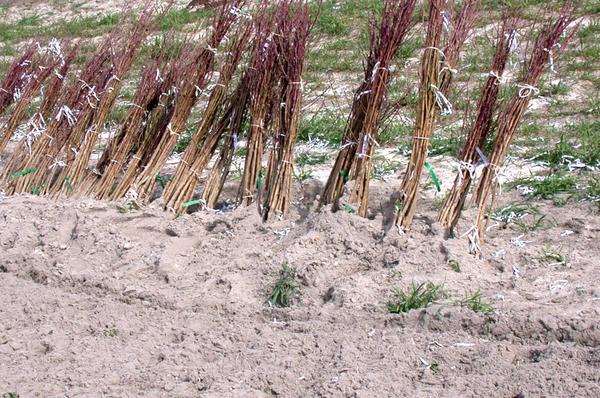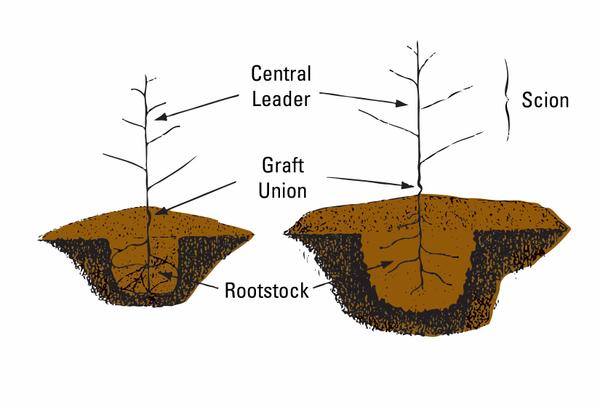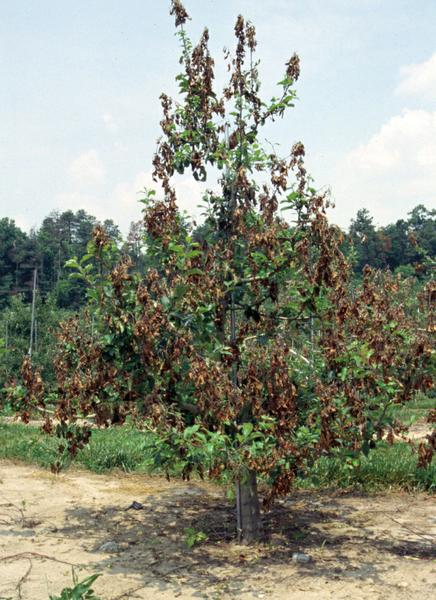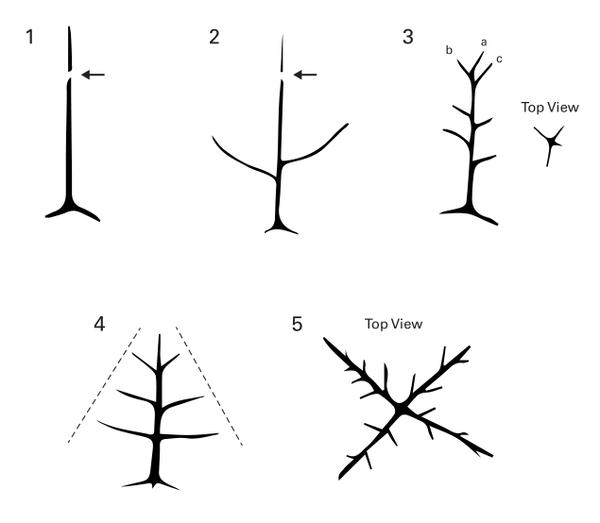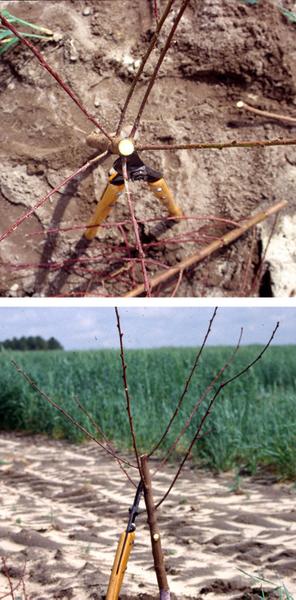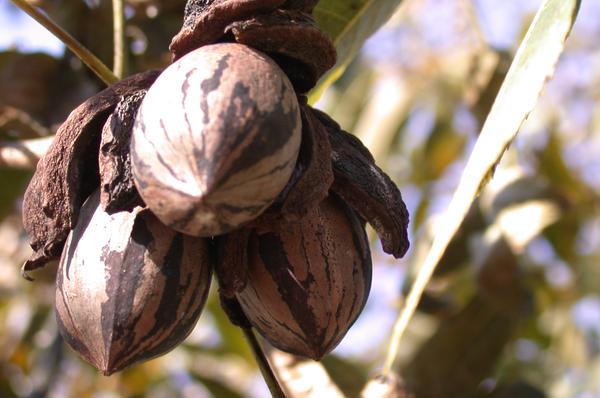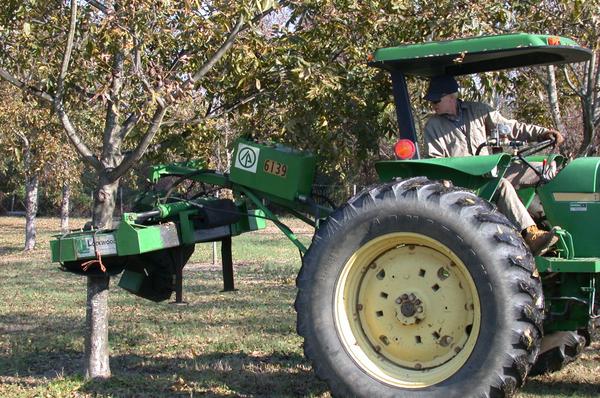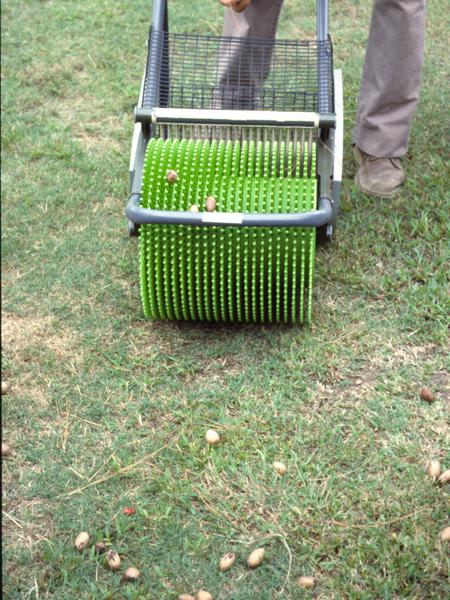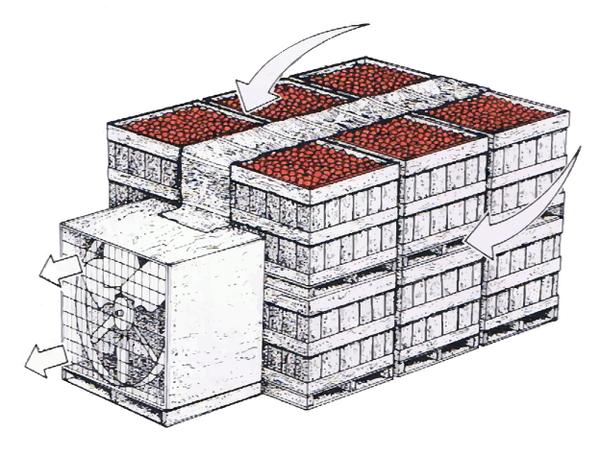Introduction
North Carolina’s climate and soils are well suited to grow many types of tree fruits. This publication will focus on the three main tree fruits produced for market in North Carolina: peaches, apples, and pecans. In addition to these main crops, information is also included for pears, persimmons, plums, nectarines, Asian pears, and figs because they grow well in North Carolina’s temperate climate. These tree fruits require similar management regimes described in this publication.
Site Selection
Site selection is the single most important factor in establishing an orchard. Light exposure, soil properties, water availability, and temperature extremes and fluctuations are important factors to consider when selecting an orchard site. Paying close attention to these details before planting is crucial.
Sunlight
Fruit trees need full sunlight to achieve maximum fruit quantity, size, quality, and coloration. Ensure that trees are spaced for a mature tree size so that they do not shade one another (see Rootstock and Planting sections of this publication).
Light must reach fruit throughout the tree canopy. Correct spacing, pruning, and training will allow light to reach the fruit. Light levels are reduced deeper in the canopy. At least 35% of light interception is required to initiate flower formation and more than 70% is required to produce high quality fruit. Tree borders should be clear of large trees and brush that can shade trees in the orchard.
Temperature
Temperature extremes, nighttime temperatures, temperature fluctuations, and length of growing season determine what fruit trees are suitable for an area. Fruit trees have a chilling requirement to successfully bud and bloom in the spring. The chilling requirement is a period of cold temperatures that is required to break plant dormancy. Temperatures optimal for satisfying a chilling requirement are from 40 to 45°F. Temperatures below freezing are less effective in satisfying the chilling requirement, while temperatures above 59°F may reverse accumulated chilling.
Damage due to early spring temperature fluctuations can occur to early flowers but also to the trees themselves (Figure 1). Early blooming varieties with lower chilling requirements are more susceptible to spring frost/freeze blossom damage.
Temperature requirements differ among apples, peaches, and pecans. Apples require warm days and cool nights for proper color development. Freezing temperatures during early flower development that do not completely kill the blossoms may result in "halo" apples, frequently called “frost ring” (Figure 2).
Peaches are especially susceptible to early spring frost/freeze events. Varieties suited for the mountains of North Carolina will be different than those appropriate for the Sandhills and Coastal Plains (see the Cultivar Selection section of this publication).
Pecans are better adapted to the warmer regions of North Carolina, and late blooming and shorter season varieties should be chosen carefully to avoid frost/freeze damage. North Carolina is on the northern border of viable climates for the improved-type pecans. We only recommend growing pecans in the eastern part of the state to avoid damaging spring temperatures, early fall freezes, and a shorter growing season.
Air Drainage
Just as proper soil drainage is important for tree roots (see Soil Drainage), air drainage is important for regulating temperature and avoiding stagnant cold air in the orchard. Choose a site that slopes downhill without obstructions. Wooded areas, buildings, and fences can cause pooling cold air that can result in spring frost damage. Avoid planting trees too close to these obstructions (Figure 3).
Orchards should be planted in the middle of the slope. A location such as a valley or bottomland where the air will pool and settle should not be planted. Wind machines or overheard irrigation can be used during spring frost events. In many areas of North Carolina we can see a 1°F difference in temperature for every 10-foot increase in elevation during damaging spring frost/freeze events. In North Carolina, when tree fruit crops are lost due to spring frost/freeze events, a temperature differential of 3 to 4°F can be the difference between no crop and a full crop.
Soils
Soil pH and drainage are important factors to consider for fruit and nut trees. The first step in soil preparation is to get your soil tested. Soil amendments will be based on soil test recommendations and are specific for the intended crop.
Soil analyses are free in North Carolina when submitted April to November and are $4 for samples submitted December to March through the North Carolina Department of Agriculture & Consumer Services. Contact your county Extension Office for information and forms related to taking and submitting a soil sample for testing.
Soil Fertility/pH
Most fruit trees, including apple, peach, and pecan, prefer a soil pH of 6.0 to 6.5. Often North Carolina soils are more acidic and may require liming before planting to raise the pH. Follow recommendations from soil test results for the amount of lime needed. It is crucial to incorporate lime and other amendments into the soil to a depth of 18 inches before planting the orchard.
Soil Type and Drainage
With proper drainage, fruit trees can grow in many soil types. Poorly drained soils will result in stunted or dead trees. This is especially a problem when trees are actively growing with leaves present. Peach trees in standing water during the season may die in as little as three days. Furthermore, wet soils are more prone to promote more root diseases.
To test soil drainage:
- Dig a test hole 18 to 24 inches deep in the proposed orchard site.
- Fill the hole with water.
- Observe how quickly the water goes through the soil.
- Standing water left in the hole after twenty-four hours indicates there may be a drainage problem.
Trees grown in poorly drained soils will require careful management and raised beds are recommended. Build raised beds at least 18 to 24 inches high and about 4 to 8 feet wide. Raised beds will need to be irrigated in the heat of summer because they lose water more quickly to evaporation. Drain tiles and ditches also may improve soil drainage but may be more expensive.
Finally, know the history of the site of the proposed orchard. This will provide insight for potential problems that you may encounter in a new planting. For example, land that has grown peaches should not be planted back to peaches for at least four to five years to avoid potential nematode problems, replant issues, and Peach Tree Short Life (PTSL) disease (see the Pests/Diseases section).
Cultivar Selection
Fruit crops that can be grown in North Carolina are listed in Table 1 and varieties are listed in Table 2. The tree fruits listed are recommended as possible fruits for market in the state. Some other fruits may grow, for example apricot and cherry trees are possible, but are known to require more maintenance and may not produce consistently.
The amount of care or maintenance needed for fruit trees varies. Figs, persimmons, and pecans are known to be relatively low maintenance crops in North Carolina. Peaches and plums, on the other hand, are examples of marketable crops that require a higher level of management.
| Fruit | Location | Management |
| Apples | Throughout North Carolina | Moderate |
| Asian Pears | Throughout North Carolina | Moderate |
| Chestnuts | Throughout North Carolina | Low |
| Figs | Eastern North Carolina and southern piedmont | Low |
| Nectarines | Throughout North Carolina except at higher elevations | Very high due to management for brown rot |
| Peaches | Throughout North Carolina except at higher elevations | High |
| European Pears | Throughout North Carolina | Moderate |
| Pecans | Eastern North Carolina and southern piedmont | Low |
| Oriental Persimmons | Eastern North Carolina Low | Low |
| Plums | Throughout North Carolina except at higher elevations | Moderate/High |
Rootstocks
Most fruit trees are grafted or budded. Grafting/budding is a process where the desired variety (scion) is propagated to the roots of a different variety (rootstock) that usually would produce fruit of inferior quality (Figure 4). However, the different rootstocks are used for several reasons to improve the quality of the fruit produced on the scion. When planting grafted or budded trees, it is crucial that the graft union is above the soil surface after the trees have settled.
APPLES
Size-controlling rootstocks are used to control vegetative vigor and reduce tree size as well as shorten the time between planting and fruiting. Trees on dwarfing rootstocks are required for high-density plantings and make management and harvest more efficient due to the trees’ shorter stature. These size-controlling rootstocks are most common in apples and are not available for pecans or peaches. Rootstocks are also chosen for insect and disease resistance, such as to fire blight, and tolerance to replant disease.
PEACHES
Disease resistant rootstocks can limit the impact of soil borne diseases, such as PTSL. PTSL is a complex that is of greatest concern in the Sandhills on light sandy soils where ring nematodes are present. Tables 2 and 3 list disease resistant rootstocks for North Carolina soils.
PECANS
For pecan trees, make sure that the graft union is at least 3 to 4 inches above the soil line (Figure 4) after the trees have settled. This will allow the trees to develop surface roots, which are involved in the buttressing at the base of the tree. Buttressing is the growth of support or prop roots near the soil surface, which gives pecan trees strength and stability during storms and other weather events. Planting a pecan tree too deep will result in poor root development and no buttressing, reducing the strength of the tree during high winds.
| Fruit | Recommended Varieties | Pollination Notes | Disease Notes | Other Considerations |
| Apples | Ginger Gold, Gala, Jonagold, Empire, Red Delicious, Golden Delicious, Crispin (Mutsu), Stayman, Rome, Fuji, Gold Rush | Requirements vary. Some varieties are self-fruitful. Others require pollination (see note 1). | Summer rots are the most serious disease problems and can destroy an entire crop. No varieties are resistant to apple scan, powdery mildew, cedar apple rust, or fire blight. | In warmer regions, red varieties may not color well. Rootstocks will affect production style. Trees on dwarfing rootstock will need to be staked. |
| Asian Pears | Olympic, Hosui, Kosui, Shinko | Two varieties are recommended to ensure adequate pollination. | Fire blight is the biggest concern. | Fruit sensitive to bruising. |
| Chestnuts | Chinese: Nanking, Meiling, Kuling, Abundance, Crane Chinese-American Hybrid: Revival, Carolina, Willamette |
All require pollination from another variety. Plant at least two varieties of the same type to assure optimal nut size and production. | Most Chinese and hybrid chestnuts are highly resistant to the chestnut blight fungus. | Many people prefer the hybrid chestnut varieties, citing superior quality over the Chinese varieties. |
| Figs | Celeste, Brown Turkey, Brunswick/Magnolia (for preserves), Greenish, Marseille | Only varieties that do not require pollination can be grown in North Carolina. | No serious disease problems except nematodes. | Fruit may drop prematurely as a result of drought or excessive shade, moisture or fertilization. Are grown on own roots. Can be cold sensitive at 12-15°F. |
| Nectarines | Summer Beaut, Sunglo, Redgold, Flavortop, Fantasia, Carolina Red (see note 2) | Self-fruitful. So not require pollination by other varieties. | Nectarines should be planted only on 'Lovell' or 'Halford' rootstocks on heavier soils. 'Guardian' rootstocks are suggested for plantings on sandier soils. The lack of hair on nectarines makes the fruit more susceptible to diseases than peaches, and a multipurpose fungicide and insecticide spray program will be required. | Many varieties were developed in California and may not do well in North Carolina. Only varieties that require at least 750 hours of chilling are recommended. Guardian rootstock is recommended on sandy soils. |
| Peaches | Candor, Redhaven, Norman, Carolina Belle (white-fleshed), Winblo, Contender, Summer Pearl (white-fleshed), China Pearl (white-fleshed), Cresthaven, Carolina Gold, Flame Prince (Many varieties are the result of a peach breeding program at NC State University and have been developed for North Carolina) |
Self-fruitful. Do not require pollination by other varieties. | A multipurpose fungicide and insecticide spray program will be needed during the growing season. | Only varieties that require at least 750 hours of chilling are recommended. 'Guardian' rootstock is the only recommended rootstock on sandy soils where ring nematodes can cause issues. 'Lovell' or 'Halford' rootstocks are suggested for peaches planted in heavier soils where ring nematodes are not present. |
| Pears | Moonglow, Magness (not a pollen source), Kieffer, Harrow Sweet, Seckel, Potomoc, Shenandoah | At least two varieties are recommended to ensure adequate pollination. | Plant only fire blight-resistant varieties. | Pears bloom earlier than apples and should be planted on higher sites. |
| Pecans |
Type I: Cape Fear and Pawnee |
Pollination by another variety is essential. One variety from each of the two types (I and II) must be used for pollination. | Scab is the most serious disease in North Carolina; however, a fungicide spray program is usually not practical. | Careful variety selection is essential to avoid frost or freeze problems and to allow a long enough season for maturation. |
| Persimmons | Fuyu, Jiro, Hanagosho (very good pollen source) (Only large-fruited Oriental persimmons are recommended for North Carolina) |
Cross-pollination is not required for fruit set but is recommended. | No serious disease problems. | If non-astrigent carieties are planted, fruit may not be suitable for eating until they are fully mature and their flesh is soft. Are very cold sensitive, suggest using trees propagated on American persimmon rootstock (D. virginiana) |
| Plums | Japanese: Methley (self-fruitful), Byrongold, Burbank, Ozark Premier (may bloom early) European: Bluefre, Stanley, Shropshire (Damson) (see note 2) |
Some varieties are self-fruitful, but planting two varieties is recommended. | A multipurpose fungicide spray program will be needed during the growing season. | Later-blooming varieties should be selected to avoid damaging spring temperatures. |
| Note 1. Pollination requirements for apples vary with variety. For varieties requiring cross-pollination, it is recommended that at least two varieties with overlapping bloom periods be planted together. For self-fruitful varieties, pollination by another variety will increase yield and quality. Note 2. To break dormancy and grow properly in the spring, peaches, nectarines, and plums must be exposed to temperatures in the 40°F range for a required number of hours during the dormant season. This period is referred to as the chilling requirement. In North Carolina, varieties with chilling requirements of at least 750 hours are recommended to prevent trees from blossoming too early in the spring, which increases the risk of frost/freeze damage and resultant crop loss. * Source: Producing Tree Fruit for Home Use, AG-28. |
||||
Orchard Design
Spacing trees within the orchard is extremely important for orchard success. Planting trees too close together could cause shading issues from one tree to the next, while planting trees too far apart does not allow the grower to take full advantage of the acreage planted. If planting for home use, take into account locations of buildings and other potential hazards that could present themselves when the tree reaches full size.
Apples
Expected tree size at full maturity will determine the spacing. Apple trees on dwarfing rootstock can be planted more closely than those not on a dwarf rootstock. Table 3 lists the most readily available apple rootstocks and planting distances. Plant multiple apple varieties in the orchard to ensure pollination.
| Rootstock | Planting Distance (ft) | ||
| Non-Spur Varieties | Spur Varieties | Vigorous Varieties | |
| Seedling | 18-25 | 12-16 | 25-35 |
| MM.111 | 14-18 | 9-12 | 20-25 |
| MM.106 | 12-16 | 8-11 | 17-22 |
| M.7a | 10-14 | 7-9 | 14-16 |
| G.30 | 9-14 | 7-9 | 14-18 |
| M.26* | 8-12 | 5-8 | 11-17 |
| M.9 and M.9 sized trees* | 4-8 | 3-5 | 6-8 |
| Bud.9* (B.9) | 4-8 | 3-5 | 4-8 |
| * Trees on dwarfing rootstocks (B.9, M.9, and M.26) should be staked. | |||
Peaches
Peach trees are not grown on size-controlling rootstocks and should be planted on an 18- to 20-foot x 20-foot spacing with the wider spacing required on optimal sites and soils.
Pecans
Pecans, like peaches, do not have a dwarfing rootstock and are typically planted on a 35-foot x 35-foot grid pattern. Trees are thinned at several intervals, ultimately arriving at a 70-foot spacing when reaching maturity at 20 to 25 years. Pecans have specific pollination requirements, which must be kept in mind when planting and designing an orchard-thinning program. Pecans are wind pollinated and require at least two trees of different types to ensure proper fruit set (Table 2).
When and How to Plant
It is best to obtain budded or grafted trees from a reputable nursery. It is extremely important to order trees ahead of the planned planting date. Planting in the fall allows for winter root growth when soil temperatures are above 50 to 55°F, resulting in better growth during the first year establishment.
When the trees arrive, they may be wrapped in moist newspaper or damp sawdust. It is important to plant the trees as soon as possible after they arrive. Do not allow the root system to dry out. If trees cannot be planted when they arrive, they may be “heeled in” (Figure 5); do not place your trees in a bucket of water for long periods of time. To heel in bare root trees, dig a trench and place the roots in the trench so that the trunk and branches of the tree come out of the trench at an angle. Replace dirt in the trench being careful not to bury the plant below the graft union. Compress dirt gently in the trench by stepping on top of the loose dirt with your foot or heel. The trees can be held here for up to a month before they will need to be transplanted to a permanent spot in the orchard.
Planting a Fruit Tree
When planting a fruit tree:
- Dig a hole twice the size of the root system.
- Loosen the soil throughout the hole and on the walls of the hole.
- Minimize any amendments such as compost and organic matter in the planting hole.
- DO NOT add fertilizer into the hole as this may burn the young roots.
- Spread the roots evenly throughout the hole, cutting and removing any damaged or excessively long roots. Make sure the graft union is above the soil line.
- Backfill the hole and press the soil firmly around the base to ensure there are no air pockets in the hole.
- Water the tree thoroughly after planting.
- Provide at least one inch of water to the tree weekly during the growing season for the first year.
IMPORTANT: When planting a grafted tree, the graft union (where the scion meets the rootstock) should be at least 2 to 3 inches above the soil after the soil has settled. Planting the graft union below the soil will encourage the scion to put out roots overriding the disease resistance or size controlling characteristics of the rootstock or, in the case of pecans, not forming surface roots (Figure 6).
Irrigation
Irrigation is strongly encouraged for fruit trees to improve tree growth and overall fruit quality. Irrigation should provide the roots with water. Low flow emitters and microsprinklers can be effective ways to water fruit trees on both small and larger scales.
Pest, Disease, and Weed Control
Management of pests, diseases, and weeds is essential for optimal tree fruit production and longevity.
Pest and disease control begins with orchard sanitation. Clear fallen leaves and infected fruit from below the trees and remove them from the orchard. Also remove any fruit left on the tree after harvest and discard away from the orchard. Many diseases and problematic insects find refuge in decaying fruit or rotting branches or leaves. Do not use fallen leaves as mulch. Cut and remove dead wood from the tree and dispose of the wood away from the orchard. Burning the dead wood can prevent persistence and spread of disease.
Scout
Throughout the growing season, walking through the orchard at least once a week is recommended to scout for potential disease and pest problems. Contact your county Extension agent for help identifying pests or diseases and recommended measures of control.
Commercially available spray combination to control disease and insect problems in the orchard are available at local garden centers. If using one of these products, be sure to follow the directions on the label, as concentration and application timings are crucial to the effectiveness of these products.
(See the Insect and Disease Control of Fruits chapter of the North Carolina Agricultural Chemicals Manual)
Disease
Fire blight is a common disease in North Carolina pears and apples (Figure 7). Currently there is no cure for fire blight, so prevention of this disease is key to the survival of the orchard. Planting resistant varieties and removing infected plant parts when first observed is recommended. If you suspect fire blight, contact your county Extension agent for identification and to discuss further action.
PTSL causes peach trees to die only a few years after planting in sandy soils. Although not much is known about this complex, PTSL is correlated to the presence of ring nematode in the soil. Currently, the best way to combat PTSL is to plant trees that are on a nematode resistant rootstock. We currently suggest using ‘Guardian’ rootstock for sandy and coarser soils in North Carolina. Preplant soil treatment is also recommended in larger plantings on sandy soils.
Wildlife
Pests in tree fruit are often thought of as insects. However, vertebrate pests such as deer, squirrels, crows, and blue jays can have a significant effect on productivity. For deer, fencing is an option, although very costly if installed properly. Noisemakers, mylar balloons, and plastic owls and hawks can be effective for a short time as the animals learn to adapt. More drastic measures, such as hunting or the use of traps, are necessary to control populations in the long-term. Proper permits are required for this type of control.
Rodents, such as mice or voles, can also be problematic. They chew on tree trunks or roots. If using mulch, we suggest using a rodent guard around the base of trees.
In addition, if mulch is used, pull the mulch back 18 inches away from the trunk during the fall to allow natural predators to help control vole populations. In all cases, monitor vole populations within the orchard. The apple sign test is recommended to minimize vole populations and subsequent tree damage and death.
Weed Control
Weeds compete with fruit trees for moisture and nutrients. Weeds can greatly reduce tree growth and fruit production. Orchards are typically managed with a bare ground strip in the tree row between trees or to the drip line for individual trees.
The strip can be managed in several ways:
- Herbicide: If using this method, follow the instructions for proper herbicide rates and application. Keep herbicide off of the tree.
- Weed-eaters and mechanical cultivation should be used with caution, staying 12 to 18 inches away from the trunk. Both can damage tree trunks and shallow roots.
- Mulch applied two to four inches thick. Mulching can help control erosion, conserve water, improve soil structure, and add nutrients and organic matter to the soil, but can create an environment for voles. Mulching is an option, but can be cost prohibitive on a commercial basis.
If planting more than a home orchard, it is important to make sure that the “alleyways” are planted in a durable grass to support machinery and minimize erosion (Figure 8).
Pruning and Training for Tree Development
Training is used to direct the growth of the tree into a desired shape or form. Pruning is a corrective process used to remove a part of the tree to maintain or correct tree structure. Major pruning should be done during dormant months, typically in late winter or early spring. Training, on the other hand, takes place periodically throughout the year.
There are two primary training systems for fruit trees:
- Central leader training is primarily used for apples, pears, and pecans but can also be used for cherry and plum trees. A single, main upright trunk characterizes trees with central leaders. A Christmas tree shape is a good example of a central leader training system. Figure 9 shows (1) First year pruning, removing leader 30–34 inches above ground; (2) Dormant pruning, remove leader 24–30 inches above first set of branches; (3) First summer after planting, determine proper leader (a) and prune off other wood around the leader (b and c); (4) Central leader system with 18–24 inches between branches; (5) Top view of central leader system showing ideal branch spacing around the tree.
- The second type of training (used in peaches, nectarines, and plums) is called open center or vase training (Figure 10). In this training system, the central leader is removed, leaving three to five limbs extending outward and upward at approximately a 45 to 60 degree angle from the main trunk. Open center training allows for optimal light penetration.
For more detailed information on tree training and pruning please refer to the publication entitled Training and Pruning Fruit Trees.
Crop load management is an important factor in producing high quality fruit. If fruit is not thinned properly, it may result in smaller fruit with less desirable fruit qualities. Peaches can be thinned by hand during bloom and up to 40 days after bloom. Apples are typically chemically thinned but can be manually thinned when they are about 1 inch in diameter. Thin to one fruit per cluster with 6 to 8 inches between fruit. How fruit is thinned will depend on orchard management practices and the size of your operation.
Harvesting
Harvesting tree fruits at the correct time is essential in the production of a marketable, high quality product. The rate of maturation depends on the variety, or cultivar, and climate. The stage of maturity will also depend on your intended market and if the fruit will be stored before selling. Fruit sold immediately will be at a more advanced stage of maturity than fruit to be held for later sales. Harvests will vary from year to year. There is no set calendar date for harvest—maturity of the fruit determines when harvest occurs.
Apples
To ensure maximum storage life, harvest apples when mature, but not yet fully ripe or overripe.
Ways to determine apple maturity:
- For immediate roadside sales, a reliable method for determining a ripe apple is to take a bite
- As the fruit matures over time, you will notice changes in maturity as exhibited by the “ground” or base skin color. The color will change from green to yellow as the fruit matures.
- A flesh firmness gauge can also be used to determine maturity.
- A starch-iodine test can be used to indicate maturity (visit Harvest Maturity Resources for instructions on performing this test.).
Immature apples will have:
- Poor taste
- Poor texture
- More susceptibility to storage disorders, including cork spot and bitter pit
- May not ripen properly
The eating quality of the apple depends on both the flesh firmness and the sugar to acid ratio flavor. The level of maturity at harvest will also influence the product’s shelf life.
Handle apples carefully during harvest to avoid bruising. Once boxed in the field, place apples in the shade and move to cold storage or point-of-sale as soon as possible.
Peaches
Determining the appropriate time to harvest your peaches will vary by variety. Depending on the variety planted, peaches might be ready for harvest between June and October. Be selective when harvesting: only choose peaches that are mature enough for shipping or for immediate marketing. A grower should be familiar with the varieties being grown, as distinctions in color and firmness indicating maturity will differ depending on variety.
It is best to harvest peaches in the early morning to minimize field heat in the fruit as well as worker fatigue. Minimizing field heat will also slow the post-harvest ripening and softening process.
The most reliable indicators for matured peaches include changes in ground color, firmness, and uniform swelling around the suture. Ground color refers to the color of the peach on the side facing away from the sun. A peach appearing light green is approaching maturation. As the ground color breaks to a white or yellow, this is a positive indication of maturity (Figure 11).
As the fruit moves through its final swell, pay attention to the fruit’s size and shape when determining its maturity. There should also be a uniform swelling of the peach around the suture so that in a cross-section the peach will be round, not oblong. To minimize bruising and premature softening during storage and transit, peaches should be at a stage of development that is advanced enough to allow the fruit to ripen to a high quality.
Pecans
Pecans are ready to harvest once the shucks split, allowing the nuts to fall to the ground (Figure 12).
One tool used for harvesting on a small scale is a long pole. A long pole has a wide, blunt end or grappling claw that is used to shake the limb. This tool may be more economical for smaller orchards. The most effective tool for harvesting pecans is a PTO powered trunk shaker (Figure 13). This piece of equipment grabs hold and “hugs” the trunk of the tree and shakes in a horizontal direction. Use caution when latching onto the trunk of the tree. Too much pressure on the tree during shaking may cause the trunk to split, leaving an open wound.
For smaller scale orchards, hand-harvested nuts should be picked up frequently to prevent molding or removal by pests. For commercial harvesters, it is ideal to mechanically rake or blow the pecans into windrows on both sides of the tree to ease in pick up. This can be accomplished through manual labor using rakes and blowers or through mechanical sweepers and blowers mounted on a tractor. It is important to use caution when moving the pecans, either through manual labor or machinery, so as not to crack the pecan shell. Once gathered in windrows, a push-powered (Figure 14) or tractor-pulled harvester can be used to sweep up the pecans and blow the trash out the back.
Post-Harvest Handling
Cooling of fruit after harvest is crucial for maintaining fruit quality if holding for any period of time. The most common method for smaller scale production is forced-air cooling (Figure 15). The objective is to get the fruit as close as possible to 32°F. The greater the movement of air in your cooler, less time is required to cool your crop. The shelf life of your crop will be significantly shortened if you are unable to properly and quickly cool the fruit.
Regularly sanitize your fruit harvest and storage containers as well as the surfaces of your cooling and storage rooms. Interior surfaces may be disinfected with a 0.25 percent solution sodium hypochlorite (1 gallon of household chlorine bleach in 20 gallons of water) applied with a pressure washer.
In addition to regularly inspecting your bulk boxes, periodically inspect and clean cooling and storage rooms, the coils, fans, and ducts. By cleaning any dirt or dust that may have accumulated, you will increase the efficiency and effectiveness of your units. Regularly recalibrate thermostats and hygrometers, used to measure temperature and humidity, to maintain accuracy.
Apples
Rapidly cool the apples after harvest to remove field heat and increase storage life. The optimum storage temperature for apples depends on the variety, but all are within the range of 32 to 36°F.
OPTIMUM STORAGE
The relative humidity should be from 90 to 95% for all varieties, which may require the use of a humidifier in the storage room. This range reduces water loss but does not encourage bacteria and fungi. Apples may also be stored in plastic bags, crates, or bin liners to prevent fruit dehydration.
Peaches
Most peaches grown in North Carolina are sold directly to the consumer as quick as possible. Peaches are:
- Picked in the morning, daily
- Placed in the shade after picking
- Sold the day of picking
For those that require more time to market their fruit, a mature peach can be stored for two weeks within the range of 31 to 36°F and 90% humidity. Maintenance of your storage facilities and the environmental conditions within those facilities is essential for sustaining a productive operation.
Pecans
Once harvested, pecans are dried to a moisture percentage of 8 to 10%, or 3.5 to 4.5% for long-term storage. Large pecan orchards may utilize forced-air commercial dryers to dry the nuts in a large trailer or container. For small pecan producers, the nuts can be dried in a burlap or onion sack in an area with moderate ventilation and warmer temperatures. Pecans can be stored at 32°F for a period of up to one year. For storage lasting longer than a year, keep the nuts in a freezer. Pecans can be stored for two years at 0°F.
Pecans can be sold either cracked or uncracked. If sold uncracked in the shell, the price is determined by the variety, nut size, shell damage, and shell cleanliness. If sold shelled, the price is commonly determined by variety, kernel color, size, insect damage, and form, which can be halves, pieces, and bits.
Potential Markets
The most important factor in determining the success of any tree fruit production is researching and planning the market before planting and growing. As a producer, it is your responsibility to plan accordingly for the eventual sale of your product before it is even grown. Potential marketing options include:
- Pick Your Own (PYO)
- Roadside stands
- Local farmers market
- Retail outlets
- Internet retail outlet or social media sites
By developing a business plan, you will identify your marketing avenue(s), business and production challenges, and finally solutions to those challenges.
On-farm retailing, which may or may not include PYO, allows for customers to visit your farm. Benefits of PYO operations include reduced labor costs; elimination of grading, packing, and storage costs; direct payment to producers; and potential customer participation in harvesting. Disadvantages to this method of marketing include assumed liability of accidents by the producer; reduced demand because of poor weather and the costs associated with providing a retail service on-site.
Selling your fruit through a roadside stand, either permanent or mobile, provides an opportunity to sell directly to the customer. This form of marketing is highly variable based on the sales you will experience from day to day. When determining a location for your stand, consider the volume of traffic frequenting the area, potential customer base, the best time of day to set up, landowner’s permission, and distance from the farm.
Farmers markets are another form of direct marketing. This style of market may be operated by a grower’s organization, local community group, or by state and local governments. To secure your space at a farmers market, you will typically apply for a space and pay any associated fees. You will need to provide your own tables, cashbox or register, display signs, receipt book, scales for weighing, and high quality products. For information about North Carolina’s State Farmers Markets in your area, visit NCDA&CS' Marketing Division.
The Internet may be an attractive marketing option for some growers in this networked culture. This form of marketing will require a working knowledge of a computer, how to manage a website, and the processing of orders. If you do not plan to sell your product over the Internet, social media websites offer you as the grower, or farmer, an opportunity to showcase your orchard and products to the community. Some pecan orchards have reported achieving as much as 60% of their yearly sales through the Internet.
Resources
Boyette, M. D., Wilson, L. G., & Estes, E. A. 1989. Postharvest Cooling and Handling of Apples. AG-413-1. Raleigh, NC: North Carolina Cooperative Extension.
Hall, C. R. 2002. Direct Marketing Guide for Producers of Fruit, Vegetables and Other Specialty Products. Knoxville, TN: Agricultural Extension Service, University of Tennessee.
Parker, M. L. 2000. Growing Peaches in North Carolina. AG-30. Raleigh, NC: North Carolina Cooperative Extension.
Parker, M. L., & Sorenson, K. A. 2004. Growing Pecans in North Carolina. AG-81. Raleigh, NC: North Carolina Cooperative Extension.
Parker, M. L. 1997. Growing Apple Trees in the Home Garden. Raleigh, NC: North Carolina Cooperative Extension.
Taylor, K. C., & Rushing, J. W. 2008. Harvesting and Handling Peaches. Athens, Clemson: Department of Horticulture, Coastal Research & Education Center, University of Georgia, Clemson University.
Walgenbach, J. 2016 Integrated Orchard Management Guide for Commercial Apples in the Southeast. AG-572. Raleigh, NC: North Carolina Cooperative Extension.
Videos
Publication date: June 8, 2016
AG-814
N.C. Cooperative Extension prohibits discrimination and harassment regardless of age, color, disability, family and marital status, gender identity, national origin, political beliefs, race, religion, sex (including pregnancy), sexual orientation and veteran status.

